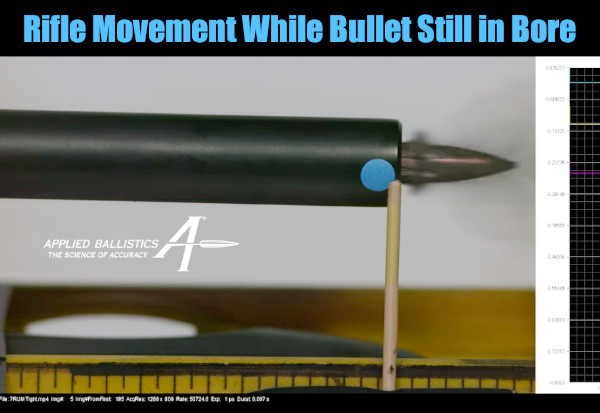This report is from Bryan Litz and the ScienceofAccuracy.com website.Since the invention of rifles, there have been debates about how much the rifle moves before the bullet leaves the bore. The first video shows a Barrett MRAD in.338 Lapua Magnum chambered with a 300gr Lapua Scenar Bullet. The ability to capture projectiles with 100k+ frames/second allows us to see aspects of the firing that would otherwise be invisible to the eye. Click Video to watch the barrel with suppressor on right move with recoil.
This video clearly shows that the rifle system moves backwards as the bullet travels through the barrel and then through the suppressor. During the “in bore” portion of bullet movement, any deviation in the muzzle direction from the initial point can cause a change in the point of impact. The bullet will exit the barrel while it is pointing in a different direction than when the shot first fired. Consistent marksmanship and recoil-management techniques can help maintain the shot’s orientation. Most shooters will not be able to manage it to less than 0.001” for every shot, especially with lightweight magnum rifles. Here’s an example using a 180gr cartridge in a Rem 700BDL.30.06 rifle. “Every time we see a video such as this, it reminds us of the fact that the majority accuracy and precision comes from the gun/sight/support systems, not the ammunition. “When you consider that 0.005″ of muzzle deflection (orthogonal with the bore) results 1.5 moa (.75 in either direction) and that you see this massive movement of the barrel prior to bullet entry, it is clear that the majority of dispersion for typical rifles comes from this movement”. Precision rifle systems such as benchrest, F-Class, and PRS rifles tend to minimize movement away from bore axis before bullet exit in order to achieve the highest level of precision. The most precise systems tend to use heavier rifles and lighter projectiles. This is related to Newton’s Third of Motion: “For every action there is an opposite reaction.” If the rifle weights more and the projectile weighs less, the motion before the bullet leaves the barrel is smaller. In our book Modern Advancements in Long Range Shooting, Volume III, Chapter 3, we cover the Theory of Precision for Rifles, which mathematically describes the precision potential of rifles and estimates it based on rifle weight and kinetic energy of bullet. The chapter includes live fire test data that supports the theory. A great discussion about the testing can be found in our podcast on the Science of Accuracy Academy site. Buy the book: Modern Advancements in Long Range Shooting, III Listen to the podcast: Science of Accuracy.

















